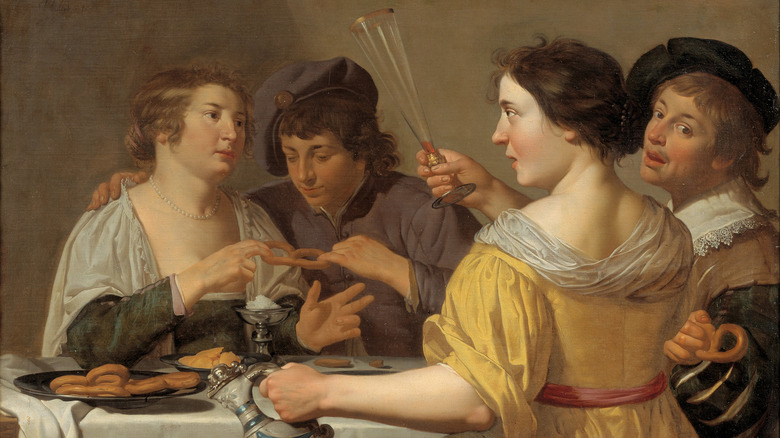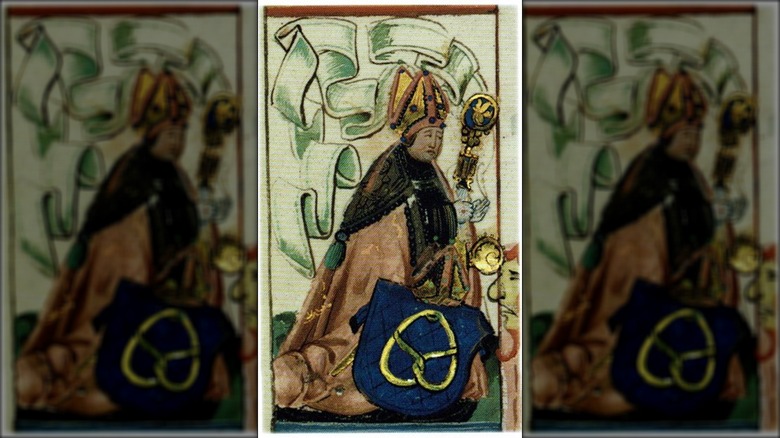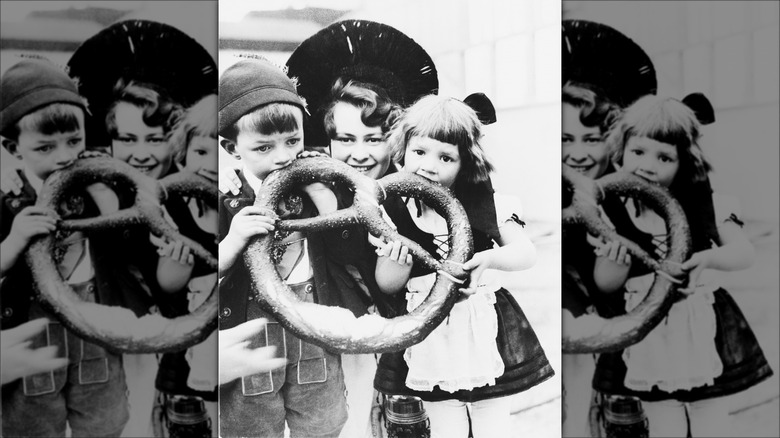Why Pretzels Became So Popular In The Middle Ages
The modern world is resplendent with every treat, sweet or savory, that anyone could possibly hope for. From fast food favorites like the Whopper and Big Mac to the many available chips, candy, and pastries, many people find it challenging to maintain a balanced and nutritious diet with all the tempting snacks that we encounter throughout the day.
But a world where all classes of society are faced with a constant barrage of tasty treats is a fairly recent one. The further one looks into the past, the more simple and practical diets appear for everyday people. For example, in medieval Europe, most peasants under feudalism subsisted on a diet of meat and veggie stews, supplemented by preserved fruits and meats and dairy products. Of course, a medieval equivalent of takeout existed in some major cities, such as London, where urbanites were able to buy hot street food such as meat pies from cookshops as they went about their day. And for many, treats were associated with religion, with the humble pretzel becoming an iconic and symbolism-infused snack in medieval Central Europe, especially Germany.
The pretzel: a monastic munch?
The exact origin of the pretzel is still debated, with various sources claiming that the instantly recognizable snack was first created in Germany, Italy, or Southern France. Nevertheless, most agree that the pretzel first emerged in its original form sometime in the early 7th century and that it was likely invented by monks who wanted to create a snack for Christian children as a reward for religious devotion.
Pretzels were originally baked as large, soft pastries, without the glaze and salt they came to be topped with. Their relevance to Christians — beyond their pleasing shape, which certainly would have appealed to children — is also related to the simplicity of their recipe. Made simply of flour, water, and salt, they were considered acceptable treats during Lent, a period in which many Christians traditionally abstain from richer foods.
In the U.S. today, pretzels are particularly associated with the state of Pennsylvania, where they first arrived with German settlers in the early 18th century, according to Sharon Hernes Silverman's "Pennsylvania Snacks: A Guide to Food Factory Tours." The advent of the hard pretzel snack that is popular in America today came in the mid-19th century thanks to a baker named Julius Sturgis. Notably, he intentionally altered the way pretzels were baked to give them more longevity — they could travel farther and stay on shelves longer — and allow him to serve more customers, according to History.
A religious symbol
Snackers in the Middle Ages didn't just look at the pretzel as a jazzy-shaped treat they could spin on their finger. The shape — created by bakers who formed the dough into a sausage shape with tapered edges, which were then crossed over one another to create the pretzel's twisted double-knot — is said to have various symbolic resonances in the Christian faith.
As described in "Pennsylvania Snacks," it is commonly believed that the pretzel shape serves a dual symbolic function. First, the crossed bands of pastry that give it its distinctive shape are believed to imitate the shape of a praying child's crossed arms, reinforcing the image of religious devotion to Christian children. But the iconic shape's secondary meaning reportedly relates to Catholic theology. Where a donut has one hole, a pretzel's double-knotted shape has three. Per the same source, some believe that these three holes may have been used to explain to children the concept of the Holy Trinity: that God in Catholicism consists of the Father, the Son, and the Holy Ghost.
As well as religious devotion, in some countries the pretzel has become a symbol of romantic love, with "Pennsylvania Snacks" reporting that the baked double-loop featured in wedding ceremonies in 17th-century Switzerland.


